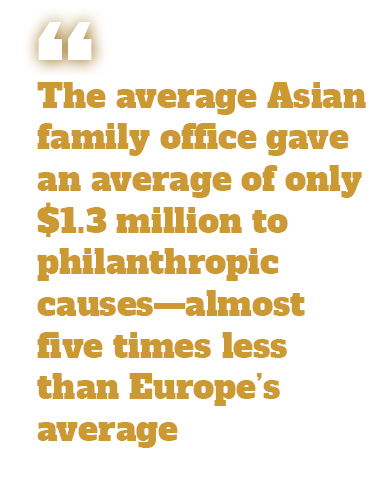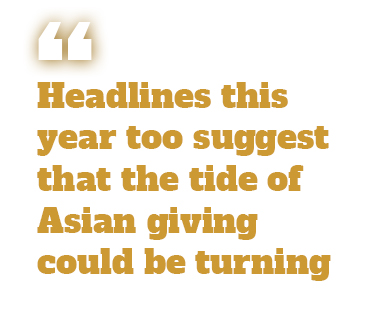View from Asia-Pacific: The art of giving

Asia’s story over the past few years has been a tale of rapidly rising wealth and with it, increased philanthropic giving. In 2014, Hong Kong real estate moguls Ronnie and Gerald Chan hit western headlines when they pledged a $350 million gift to Harvard University through their charitable foundation—the largest in the institution’s history. In its 2016 study on philanthropy, BNP Paribas said that 27% of high net worth Asians planned to leave at least a third of their fortune to charity.
But in 2018, at a time when personal wealth in Asia is at an all-time high, new reports have suggested that the Asia region is lagging further behind than it should be.
According to the Centre for Asian Philanthropy and Society’s Doing Good Index 2018, the region’s philanthropists are capable of giving around 11 times more than the $45.5 billion it currently gives. The report’s researchers reasoned that with a combined GDP of $25.4 trillion, charitable giving by philanthropists across South Asia, East Asia, and the Pacific could potentially reach $500 billion. This level would be reached if the region gave the same 2% share of GDP that the United States does.
 Elsewhere, the Global Family Office Report 2018by Campden Research and UBS finds that the average Asian family office gave an average of only $1.3 million to philanthropic causes—almost five times less than Europe’s average of $6.4 million.
Elsewhere, the Global Family Office Report 2018by Campden Research and UBS finds that the average Asian family office gave an average of only $1.3 million to philanthropic causes—almost five times less than Europe’s average of $6.4 million.
Are these comparisons perhaps a little unfair? And do they illustrate the wider story in Asia?
Historically, charitable giving in Asia has been seen as a personal affair and not something to declare publicly. Because of this, it has been difficult for researchers to chart the scale and scope of philanthropy in the region. The Doing Good Index 2018notes that far from not wanting to donate to charitable causes, Asian philanthropists have hesitated giving to charitable organisations in their region, due to a lack of clarity; and scandals involving charities. Philanthropists say governments could help address this by encouraging more transparency and accountability; and ensuring relevant regulations for the sector are easily understood.
Headlines this year too suggest that the tide of Asian giving could be turning, despite these reservations around transparency.

In March, Hong Kong billionaire Li Ka-Shing said he would retire to focus on his charitable foundation, which he affectionately calls his “third son”. Four months later, Jack Ma, one of China’s richest men and co-founder of e-commerce behemoth Alibaba, also announced his plan to retire to pursue philanthropy in an area close to his heart—education. In announcing his next move, Ma credited Microsoft’s Bill Gates for inspiring him to create a personal foundation for his philanthropic ventures.
“There’s a lot of things I can learn from Bill Gates,” he said at the time.
“I can never be as rich, but one thing I can do better is to retire earlier.”
As more wealthy investors get inspired to follow suit, and with the region’s wealth projected to keep growing, could Asia become the new world leader in philanthropy?






